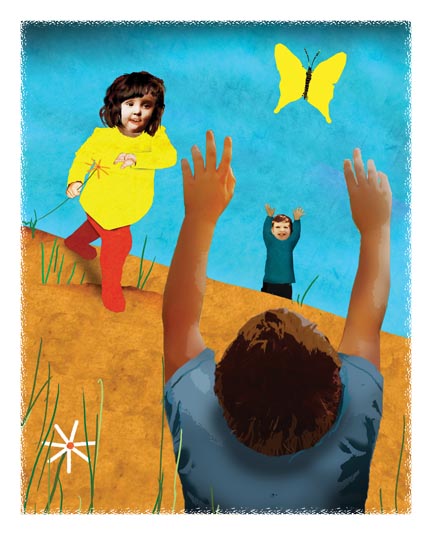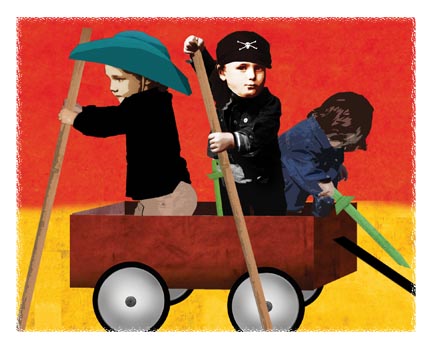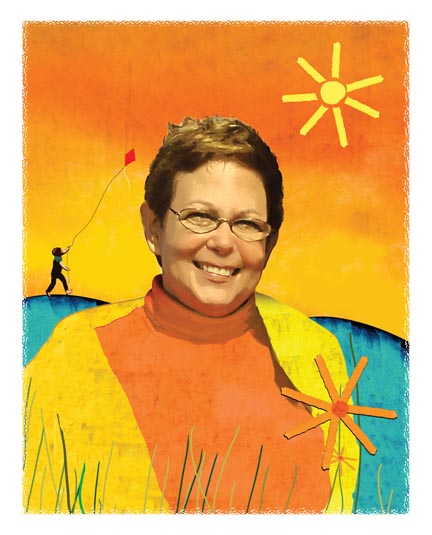The Dances of Adele Diamond
Children need imaginative and vigorous play in order to help their brains develop, says cognitive neuroscientist Adele Diamond ’74.
 One need not look too hard to find Adele Diamond dancing, but it has to be a certain kind of dance—a subtle combination of social, rule-based, and interactive.
One need not look too hard to find Adele Diamond dancing, but it has to be a certain kind of dance—a subtle combination of social, rule-based, and interactive.
“I hate the way ballroom dancing is taught in dancing schools,” says Diamond. “They teach that you’re supposed to look over your partner’s shoulder. I don’t want to dance with somebody who’s looking over my shoulder. I want the interaction….
“Salsa, swing, tango, contradance from New England, hambo from Sweden,” she says, listing some of her favorites.
Diamond—a professor of developmental cognitive neuroscience at the University of British Columbia—also dances, metaphorically, in her field, which is interdisciplinary and has that same subtle combination of social, rule-or research-based, and interactive. As one of the world’s leading researchers in developmental science, she is at once a neuroscientist, a psychologist, an anthropologist, and an educational innovator. She interacts with a wide variety of folks, from academicians to physicians to the Dalai Lama to her main focus—school-age and preschool children. And she insists, too, that they also should be “dancing” with her.
“In square dancing, contradancing, or Cuban-style salsa (Rueda), where pairs of partners are also part of a larger whole, dancers interact not only with their partners but with everyone else in the larger whole,” Diamond says. “If everyone does his or her part exactly right, the larger whole ebbs and flows as one organic entity. Yet, within this wonderful experience of community there is still room for each person to have his or her own special way of doing things. This is how children should be allowed to develop.”
Diamond studies what are called “executive functions,” the kinds of activities that are dependent on the prefrontal cortex (PFC) of the brain. Executive functions are critical for decision-making, reasoning, and problem-solving. These brain functions help us resist acting on our first impulse so we don’t do something we’d regret; they help us relate what happened earlier or what we learned earlier to what we are learning now; and they help us to think outside the box to come up with new ways to help us solve problems.
“Adele made one of the first links between early cognitive development and the functions of a specific neural region,” says Emily Jacobs, a Robert Wood Johnson Foundation Health and Society Scholar who first met Diamond as an undergraduate at Smith College a decade ago. “By demonstrating that maturation of the PFC plays a role in the emergence of working memory and inhibitory skills in infants, her work marked a milestone in the integration of developmental psychology, cognitive science, and neuroscience. It laid to rest old assumptions that the PFC was functionally silent during infancy and, moreover, demonstrated that work in neuroscience might inform work in developmental psychology and vice versa.”
Jacobs adds that, in Diamond’s research, “curiosity and compassion commingle. She is committed to mentoring young scientists and dissolving the barriers between scientists and the general public.”
DIAMOND'S RESEARCH HAS FOCUSED PRIMARILY on how to develop executive functions in the early years of life—even among infants—to produce children, and eventually adults, who are well-adjusted, confident and strong.
Her conclusions, while not entirely surprising, are definite: Basically, kids need hands-on problem-solving, not academic force-feeding. Children she has studied who played more did better on academic thinking than their peers who spent more time just on academics.
 “You have to address the whole child—the cognitive, social, emotional, and physical,” Diamond says. “People say, ‘Let’s be efficient and only stress what we care about.’ It turns out that this is inefficient and does not lead to the best results. All the different parts are interrelated. If you are feeling lonely or stressed, your mind doesn’t work well. If you want to have kids thinking well, they need to not be stressed, need to feel that they belong, and need to be in good physical shape.
“You have to address the whole child—the cognitive, social, emotional, and physical,” Diamond says. “People say, ‘Let’s be efficient and only stress what we care about.’ It turns out that this is inefficient and does not lead to the best results. All the different parts are interrelated. If you are feeling lonely or stressed, your mind doesn’t work well. If you want to have kids thinking well, they need to not be stressed, need to feel that they belong, and need to be in good physical shape.
“When working toward a shared goal such as ensemble dancing,” Diamond explains, “people work together and have the sense of belonging to that group. They also have the joy of doing something they love. They are fulfilled in that they have a feeling of accomplishment. They are physically active, so their brains and executive functions work better. They have to concentrate and hold complex sequences in mind, so their executive functions are challenged, too.”
“This is the beauty of Adele,” says Thomas Schilling, professor of psychological science at Fitchburg State University in Massachusetts and a longtime colleague of Diamond. “She does great basic research but has the companion career of applying it. She has done things in biology and chemistry, like her research into the dietary disorder phenylketonuria [PKU—a genetic disorder that blocks the metabolism of a certain amino acid and, if untreated, produces widespread brain damage] but then has come up with solutions, such as modifying diets. It is her work in education, though, that will be landmark. If there were a Nobel Prize for psychologists, she would be the first I would propose to win it.”
While she appreciates the kudos, Diamond would rather continue her research and find ways to make sure children get educated toward being people who are happy, capable, and confident—both while they are children and when they become adults.
“The end result we should be looking for is an adult who feels him- or herself worth the effort it takes to be self-disciplined,” Diamond says. “Executive function skills, such as sustained attention, are stifled by video games and TV programs that assume short attention spans and keep changing things to grab one’s attention.”
Although not seemingly all that different from the “it-was-better-when-I-was-a-kid” crowd, Diamond’s views are based in basic research. To follow up on her studies of those executive functions in the prefrontal cortex, she has gone into classrooms with children of varied ages, socio-economic standing, and types of neighborhood, watching and recording how children react when she gives them various problems to solve. She’s looking primarily for evidence of crucial executive functions such as self-control or inhibition, working memory, and directed attention and flexibility of responses to any situation. If a child appears not to be able to do or understand something, Diamond looks for ways she can present the problem differently so the child can succeed. “A shift of perspective can be helpful in teaching,” she says. “If a child isn’t getting something, how might I, as the teacher, present the material differently or word the question differently, so that this child can succeed? Children need to be allowed to discover things for themselves. Knowledge is not something that can be poured by a teacher into the empty vessel that is the student.”
“It’s not a cookbook type of thing, where what is good for Child A is also good for Child B,” she says. “The teacher has to be like a scientist and learn what is good for each child. So maybe if Johnny isn’t getting it, it is as much my problem as his teacher as it is Johnny’s. It’s exciting and fulfilling but difficult yet doable. If children are working in small groups or independently (and children learn best actively engaging the material rather than listening to lectures), then it is not a problem for a teacher to give individual attention to a child.”
Some of her recent research involved observing children who are participating in a preschool educational program called Tools of the Mind, which uses a lot of creative play methods in teaching—what Diamond calls “social dramatic play.”
 “You let children pick what play scenarios they’d like to do, and they tell you their plan. If, after a few moments, they are ready to abandon that for something else, you come to them with their plans and say, ‘You committed to this. You need to continue to be the astronaut who goes to the moon, because you picked that. This afternoon or tomorrow, you can be the race-car driver.’ During such pretend play, children experience exercising inhibition by resisting acting out of character. They learn to be flexible when they have to react on the fly to what their friends are doing in the improvised scenario,” Diamond says. “Technology—video games or watching TV—does not help to develop these skills.”
“You let children pick what play scenarios they’d like to do, and they tell you their plan. If, after a few moments, they are ready to abandon that for something else, you come to them with their plans and say, ‘You committed to this. You need to continue to be the astronaut who goes to the moon, because you picked that. This afternoon or tomorrow, you can be the race-car driver.’ During such pretend play, children experience exercising inhibition by resisting acting out of character. They learn to be flexible when they have to react on the fly to what their friends are doing in the improvised scenario,” Diamond says. “Technology—video games or watching TV—does not help to develop these skills.”
Diamond stresses that learning how to do something initially is different from being fluent in it later on—and the learner uses different parts of the brain in each step.
“When you are learning to ride a bike, say, you are concentrating on all the new things and using your prefrontal cortex,” she says. Then as you perfect riding the bike, the activity moves to the “older” parts of the brain where you don’t need to be thinking about every motion and where the act of riding a bike is natural. It’s the same with her dancing—or anything else, like playing chess. “When I first learn a dance, I have to think about what my feet are doing. I use my PFC. But once I learn it, I mess up if I use my PFC and think about what my feet are doing. The older parts of the brain take over, and the dance flows,” she says.
By studying all of this—the workings of each part of the brain—as a developmental neuroscientist, she has continued to be fascinated by learning, particularly in childhood.
DIAMOND GREW UP IN NEW YORK going to good public schools, she says, but her father died during her senior year in high school. She says she was able to come to Swarthmore because the College gave her a full scholarship, and while there she danced around with psychology, anthropology, sociology, and philosophy. She won a graduate fellowship to go to the South Pacific to study cultures there but instead, she went for a Ph.D. in developmental psychology at Harvard, studying under an adviser, Jerry Kagan, whose passion for the field was “infectious” and who led her to her eventual research.
“All over the world—Africa, Asia, Europe, the United States—poor kids, rich kids, kids on kibbutzes, kids at home, kids in day care are all showing the same cognitive changes at roughly the same age. It can’t all be learning. It can’t all be experience. Their experiences are too different,” Diamond says.
From Harvard, Diamond went to Yale School of Medicine to learn more about the brain in a postdoctoral fellowship in neurobiology. She was among the few looking at the PFC, which has guided her since.
Her work with children also involved PKU. She determined that the brain damage associated with the disorder could be selective, limited to the prefrontal cortex and executive functions. Her research led to stricter treatment for the disease, which has improved the lives of thousands of children.

A study of Tools of the Mind, a new educational system designed to improve executive functions (also called cognitive control) in preschool children, showed that although these skills are rarely taught in conventional curricula, they can be. Based on the work of Russian psychologist Lev Vygotsky (1896–1934), Tools focuses on developing cognitive skills through structured play. In a Science article co-authored by Adele Diamond (above), the authors reported that children trained with Tools showed an executive function advantage in nearly every measure tested.
“Her work is excellent,” says Judy Livant Rapoport ’55, chief of the child psychiatry branch of the National Institute of Mental Health and the author of The Boy Who Couldn’t Stop Washing, a seminal study of obsessive-compulsive disorder. “She studies brain changes in normal early development and shows how cognitive stimulation, for example, can help children with poorer attention, impulsivity, or deprived backgrounds. She has an unusual background in behavior, development, and neuroanatomy and so is uniquely trained.”
Diamond also gets plaudits from an even more unusual source, the followers of the Dalai Lama. Several years ago, she was invited to a meeting with the Dalai Lama at a conference centered on attention and how to keep it.
“The speaker sits in an armchair next to the Dalai Lama, who is also sitting in an armchair. So it is supposed to be like it is an intimate discussion that everybody else is privy to,” she says. Diamond delivered her talk but then had a pointed question for the Dalai Lama himself: “I asked what Tibetans and Tibetan Buddhists do to train attention in young children. And [the Dalai Lama’s interpreter] said, “With young children what we do is train them in memorization. They are given passages to memorize and recite.”
That, she says, got her thinking about how she used to have to memorize things in school and how she hated it, but that maybe it was indeed a good exercise. “Maybe we’ve gotten rid of [memorization] too quickly,” she says. “Maybe it’s an important mental discipline.”
Diamond feels that the best work of Tibetans under the Dalai Lama stresses compassion (doing for others)—finding fulfillment in that and working all aspects of the executive functions. And her own avocation in dance has suggested to her that more frequent use of play and the arts in the classroom would serve all children in improving executive functions and academic outcomes.
“I think things like storytelling and dance should be helpful, but as yet we have no data on the arts,” she says, putting on her researcher’s hat (or maybe toe shoes). Part of her upcoming research will involve how dance affects those executive functions. “We will be using a Cuban-style salsa done in a circle. You have to change partners throughout the dance. The circle should ebb and flow. If someone doesn’t get it, the whole circle doesn’t work.
“It is not to embarrass anyone but to show that there are some activities in which we need everyone and everyone belongs,” she says. This is not just the cliché of “No Child Left Behind,” she adds. “The goal is to have every child, every person, have a place. That is what a well-functioning society should aspire to.”
Robert Strauss says his forthcoming book, Daddy’s Little Goalie, is a “funny, sentimental memoir about being the (often confused) dad of girls who excel at sports.” A frequent contributor to the Bulletin, Strauss is a graduate of Carleton College.
 Email This Page
Email This Page